Agrobiodiversity Conservation And Tribal Women of Koraput, Odisha
Smita Mishra
S. S. Chaudhury
Nambi, V. A.
| Introduction | Results and Discussion |
| Study Area | Recognitions and Awards |
| Data and Methods | Conclusion |
Abstract
Koraput, a tribal dominated district of Odisha, India is well known for its rich biological and cultural diversity. Recently, it has been declared as Globally Important Agricultural Heritage System (GIAHS) site by Food and Agricultural Organisation (FAO) for its unique traditional agricultural system. The region forms a part of the 'Jeypore tract' established as one of the centers of origin of rice. Women play a key role in agriculture and have conserved a large number of traditional crops and varieties of which rice occupies a prime position. Utilizing traditional knowledge and skill, they select and cultivate diversified rice varieties on farm to fulfill their socio cultural and religious needs apart from food and nutrition. This paper documents, based on primary field data and reports collected over a period of fifteen years through various interactive and participatory programs, the traditional knowledge and practices adopted by tribal women in agrobiodiversity conservation and its utilization in the tribal villages. It is observed that tribal women need to be trained with improved cultivation practices to increase production, conservation and utilization of traditional crops.
Keywords: Agrobiodiversity, rice, tribal women, conservation, Koraput, India
Agrobiodiversity also known as Agricultural biodiversity or the genetic resources for food and agriculture is largely the result of natural selection processes, and the careful choice and inventive developments by farmers, herders and fishers over time (FAO, 2005). It is a vital sub-set of biodiversity, and assumed as the direct consequence of human and nature's interaction as it has a profound relevance to food, livelihood security and economic development of people at local, regional and national scale. The role of farmers in the development is crucial as cultural and social diversity encountered amongst them has a guiding hand in its creation (De Boef, 2000).
Since the advent of crop domestication, women have performed a major role in plant selection, domestication, enhancement and conservation and a distinct role in planting, weeding, harvesting, threshing, seed selection and storage ( Mishra et al., 2012). Women maintain a traditional role in seed management in shifting cultivation too (Swaminathan, 2000). They account for fifty percent of overall food production in Asia; South Asian countries recognizes women's role in post-harvest operations, seed management and maintenance of biodiversity by transmitting their traditional knowledge on crop production to the younger generation by involving them in the whole process. They have been maintaining the genetic diversity of diversified crop species adaptable to fluctuating weather patterns and biotic pressures by ensuring the survival of traditional crops in local conditions.
Koraput region of Odisha is recognized as a Globally Important Agricultural Heritage System (GIAHS) site in 2012 by FAO for maintaining unique tribal traditional agricultural practices, conservation and utilization of inherited traditional knowledge for local food security vis-à-vis cultural diversity (Khoofkhan and Alteiri, 2011). Under traditional agricultural systems tribal farm families are maintaining genetic diversity of a variety of local crops and women are important to this type of farming and prefer to cultivate various crops that provide food security. They spend extra time and energy in processing the local food crops as they give importance to crop diversity (Sharma et.al., 1996). They make best use of the diversity by fulfilling the nutritional needs of the family members. Since time immemorial, being the major agricultural workforce, women have been conserving and utilizing the local crop varieties through regular crop production using traditional knowledge and skill (Mishra and Chaudhury, 2012). Their innovative practices and associated knowledge in seed selection, production and seed exchange (supply) has been vital for on farm conservation and sustainable utilization of indigenous crops and varieties specifically rice (Mishra et al., 2012).
Study Area
Koraput district which forms a part of Jeypore tract is well-known in rice literature as one of the centers of origin and diversity of Asian cultivated rice (Figure 1) (Ramiah and Ghose, 1951; Oka and Chang, 1962).

Figure-1: Jeypore tract- center of origin of rice and Koraput region.
The region is famous for its rich biological and human cultural diversity, with notable genetic diversity of diverse cultivated crops (Das, 2006). Tribal communities (Fig. 2) residing here belong to the Proto Australoid ethnic stock speaking Austro Asiatic language (Mohanti et al., 2006).
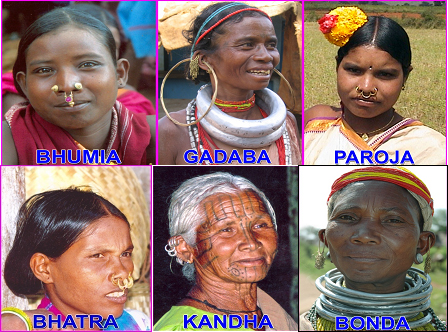
Figure- 2: women representing from different important tribal communities residing in the area.
Sixty two different communities of varying population represent nearly 55% of the total population of the district. Of the total population, 83% live in rural areas with their age old traditions and customs (Mohanti et al., 2006). Agriculture is the primary livelihood. Cultivation is carried out at different altitudes varying from 150 - 1000 meters above sea level (Senapati and Sahoo,1966- Koraput District Gazetteer) as a result of which uniformity in cropping pattern is not observed (Fig.3 ).
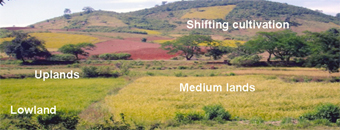
Figure-3: Agriculture practices in different altitudes and topography.
Rain-fed agriculture covers 74 % of the cultivable lands. Rice is the major crop occupies nearly 60% of the total cultivable area with traits tolerance to physiological and ecological stress, disease and pest (Tripathy et al., 2005; Mishra and Chaudhury,2010). Tribal communities have preferences for these landraces for their cooking quality, palatability, suitability for value addition, long straw for thatching and fodder (Fig.4).
The other crops grown are maize (Zea mays), finger millet (Eleusine coracana), little millet (Panicum milliare), italian millet( Setaria italic), pop sorghum (Sorghum bicolor), green gram (Vigna radiata), black gram (Vigna mungo), pigeon pea (Cajanus cajan), horse gram (Dolichos biflorus), niger (Guizotia abyssinica), mustard (Brassica juncea), sesame (Sesamum orientale), groundnut (Arachis hypogea), etc. A detailed description of the crops and plant species available in the area and their utilization is available in literature (Mishra and Chaudhury, 2012). A few examples of the crops grown in the area is shown in figure-5.
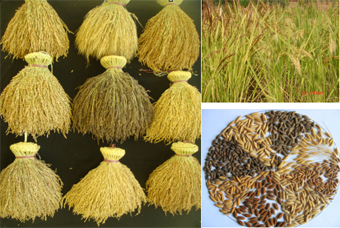
Figure- 4: Example of Genetic diversity of rice in the study region

Figure-5: Traditional food crops of tribal communities
Data and Methods
In 1995, M.S.Swaminathan Research Foundation (MSSRF), a Chennai based NGO formulated a program "Chronicling the Intellectual Property Contribution of Tribal and Rural Farm Families with regard to Rice Genetic Resources" to document the traditional knowledge and indigenous technical knowledge of tribal women and men to protect their Intellectual Property Rights (IPR) (Tripathy et al., 2005). This was followed by Traditional Conservation of Biodiversity in Tribal Communities, Gender Dimension and Biodiversity Management and Biodiversity Conservation, its sustainable utilization and poverty reduction to document their traditional knowledge on plant genetic resources particularly rice including its utilization pattern.
Extensive field studies are carried out in 8 tribal dominated villages (Patraput, Tolla, Pujariput, Nuaguda, Gunthaguda, Boliguda, Jhalaguda, Sana Taliaguda) of 3 Community Development blocks (Jeypore, Kundra and Boipariguda) (Figure-6).

Figure-6 : Map showing the eight study villages
Focused Group Discussions were held in each village to document their traditional knowledge and practice on agricultural crops and cultivation methods. Emphasis was given to traditional rice varieties cultivated by the farming communities. Special sittings were organized with the women to collect data on planting, weeding, harvesting, post-harvest operations, seed management, storage practices, household food needs and various indigenous ways adopted by them. The paper summarizes the data collected through various programs and highlights the involvement of women and men at various stages in agro-biodiversity specifically rice cultivation ( Table-1).
Results and Discussion
Usually, tribal women are considered as economic assets as they are significant earning members of their respective families. In addition to their household activities, they work in the agriculture field and as wage labour for civil works, engage themselves in the collection of Non Timber Forest Products (NTFP) as well as in other income generation activities. Although they contribute to the family's income, they remain deprived of the legal share in family's property distribution. Though, they enjoy equal social status and freedom in the society; they are not included in the traditional village panchayats. Girls are allowed to select their spouses, and have the liberty to divorce and remarry other men of their choice (Tribes of Orissa, 2004; Sharma et al., 1996). Yet, a rigid sex-based division of labour prevails, and traditionally women are allotted jobs mostly in the domestic sphere and agricultural fields that are time consuming and drudgery stridden. Spending long hours in the agricultural fields and post harvest activities help them to acquire an extensive knowledge on traditional farming. They play main role in traditional agriculture such as clearing bushes on the hills for shifting cultivation, breaking clods with a handmade hammer for land preparation, besides extending help in each and every activity in the agriculture. Their post harvest activities are most important, which assume leading role in conserving the crop genetic resources.
Earlier, we have documented 256 traditional rice varieties, 8 minor millets, 9 pulses, 5 oil seeds, 3 fibres and 7 vegetables to protect the Intellectual Property Rights (IPR) of tribal and rural men and women for future benefit sharing (Sharma et. al., 1998). Rice being the staple food for all the tribal communities and a huge diversity exists amongst rice varieties in the region, a detailed study was undertaken.
Rice is cultivated in dry, semi-dry and wet conditions in the uplands, medium land and lowlands respectively. In dry system, rice is cultivated under mono cropping or mixed cropping with many other crops. In mixed cropping, they grow a few specific crops that have varying periods of maturity harmonizing with their agro ecologies and socio economic setting (Fig.7). In general, few (2 ~8) crops e.g., rice, millets, pulses, and oil seeds are mixed in different proportions and grown together. Finger millets are known as life saving crops as it provides food to the family during acute food shortage in September (Sharma et. al., 1996 and Das, 2006) followed by short duration rice, medium duration little millet and ends with long duration black gram, til, alsi , pop sorghum and hill gram. The mixed cropping supports perennial supply of food over a period of time. In this type of cropping, complete failure of crops normally does not happen due to biotic and abiotic factors.

Figure-7: Mixed cropping field showing five different crops grown.
Tribal women take the prime responsibility of mixed cropping when landholdings are small. Applying inherited knowledge and experiences they select appropriate varieties and proportionate amount of different crops for a small patch of land to meet the family food requirement. The harvesting starts from September and continues till January. They take the sole responsibility of food processing like sun drying of the rice, ragi and other grains before manual pounding followed by winnowing, physical cleaning and food preparation that takes 2 ~ 3 hours daily. Making of ragi powder, using stone grinders, is a daily routine job. Thus, regular involvement in food processing contributes in conservation of various food crops in the local conditions.
Mono cropping of rice is a family enterprise shared by both men and women. The labor is divided based on age and sex; men mostly plough the field and sow seeds and women are engaged in uprooting, transplanting, weeding and rouging (Fig.8). Entire family gets involved in seed selection, transportation of the harvest, threshing, storage of the crop for successive year. But women's contribution to food production remains central as they spare more number of hours and withstand the drudgery.

Figure - 8: Tribal women engaged in rice farming.
They choose rice varieties on various considerations such as good cooking quality (non-sticky) rice, less consuming cooking time, swelling after cooking, slow digestion and longer stay in the stomach to provide continuous energy, suitability for value added products like popped, puffed, pressed rice, milling quality of rice, ratio of rice to husk and long and strong straw for easy harvest, thatching and animal feed. Preferentially, short duration varieties are opted to feed the family in scarcity period that leads to conservation of huge number of rice varieties on farm.
Traditional knowledge facilitate to identify crop plants from weeds looking at the leaf sheath and color during uprooting allowing to maintain genetic purity of the rice varieties. Weeding is carried out to provide space and nutrients for optimal growth of the rice plants. Rouging is done prior to harvesting for removing off types (wild rice, mixtures and hybrids) from the field to maintain uniformity of the variety (Fig.9). Transplanting, one of the most rigorous work, is carried out mostly by women for better yield. Winnowing and cleaning is done by checking the pigmentation and husk colour to remove unwanted grains. Using their specfic skills, they identify varieties with lodging resistance, higher tiller density, long panicles, cooking quality and tolerance to disease and pests arising due to climate change( Mishra and Chaudhury, 2010).
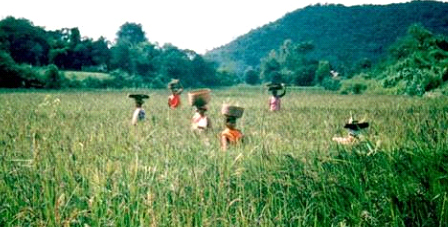
Figure-9: Group of women involved in rouging activities.
Women take the lead in selecting seeds based on husk color and grain size. The seeds are selected at two different stages i.e., before sowing and after harvesting. At home tribal women perform specific customs and rituals related to rice seeds. Seed selection procedures have been standardized by them for short and medium duration varieties. They clean the seeds for short and medium duration varieties by sinking three-fourths of the basket in the water and stirring continuously by hand allowing weed seeds, chaff, straw and small undersized light weight grains to float atop (Fig.10). On discarding the floating waste, they pass the seeds to male members for sowing. This selection process results in a comparatively higher germination percentage and fewer weeds in the field.
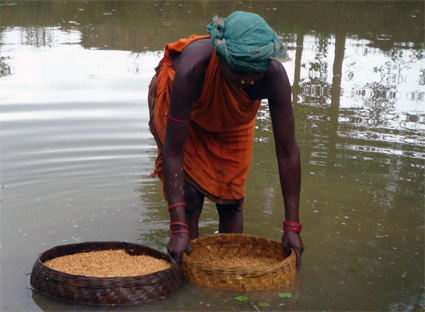
Figure- 10: Seed cleaning / selection procedure before sowing
In panicles selection, generally, the entire family gets involved as it demands time and labour. While selecting panicles from the field, importance is given to visible physical characters such as; disease free healthy plants and well-filled heavy panicles with bright-coloured husk. Plants are selected either from a good patch or randomly from the whole field (Fig.11). This process is followed to purify a desired landrace or for seed production for local trading.
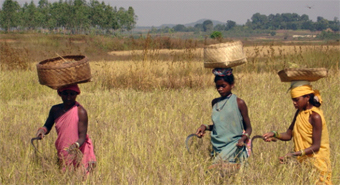
Figure-11: Seed selection from the panicle
Similarly, before threshing, women pick healthy panicles from the harvested crops (Fig.12) and thresh them separately by stamping by foot instead of threshing by bullock to keep the seed (embryo) intact (Fig.13).
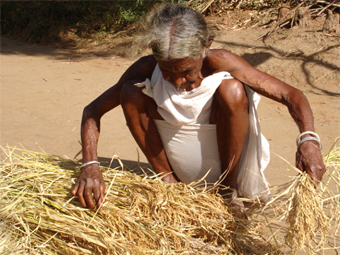
Figure-12. Panicle selection from the threshing yards
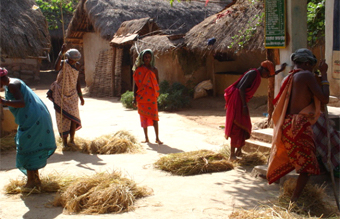
Figure-13: Threshing by leg for pure and intact seed
Occasionally young girls help their mothers in this process by winnowing and physically picking out under-sized and off-color grains, sand etc. to clean the seeds and get rid of impurities (Fig.14). After winnowing, the seeds are sun-dried on cow dung smeared floor for 2-3 days and stored for further use in the next sowing season.
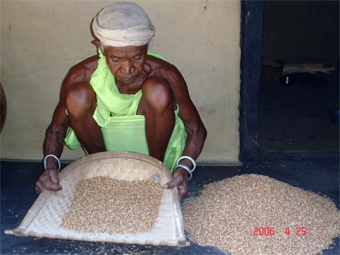
Figure-14. Physical examination and sorting of seeds.
Mostly, women separate out the required amount of grain to save as seed from the total threshed harvest and do bulk sieving to separate out the seeds of wild rice and weeds (Fig.15).

Figure-15: Seed selection by sieving from the threshed paddy
Till date the tribal culture is integral to the selection and preservation of healthy rice plants for seed selection. Bandapana Parab is celebrated in the month of August for selection of healthy plants for seed selections. Women tie hand-woven threads dipped in turmeric water to select healthy plant to ensure tillering vigor and a bumper crop harvest. Men and women participate in harvesting and transporting from field to threshing yard. Women go to nearby villages for harvesting. Rice seeds are stored in locally made structures called "Dhoosi" and "Khaniki"; Dhoosi is made up of long straw rope twined spirally and Khakini is a bamboo basket plastered with cow dung that maintains the moisture level and protects the seeds from insects (fig.16).

Figure-16. Traditional seed storage ( Dhoosi) and grain storage (Khaniki) structures
Men and women work together for rice harvesting; however, women and young girls take a lead in harvesting the crop and take an extra drudgery by spending long working hours in the field. Men prepare bundles and both together transport the harvests to threshing yard (Fig.17). Women mostly opt to go to nearby villages for harvesting and sharing of labors during harvest is the usual practice of the tribal and rural communities. This practice does not allow monetary transaction between them, rather helps in building harmonious relationships within the village or the community.

Figure-17: Transportation of harvested paddy to the threshing yard
The paddy is threshed in the yard by using cattle (either bullocks or buffaloes). The women give a helping hand to their counterpart in preparing the threshing yard and cleaning it before threshing the paddy if the quantity is more (fig.18). When quantity is less women take the responsibility of threshing the paddy in a group of two or three.

Figure-18: Male and Female sharing labor in threshing yard
Responsibility of food processing for household consumption lies with the women. Sun drying of grains in the morning and pounding by leg or hand is a routine work demands nearly 3 to 4 hours daily. The traditional leg pounder (Dhenki) or hand pounder is used and winnowed by hand and cleaned (Fig.19).
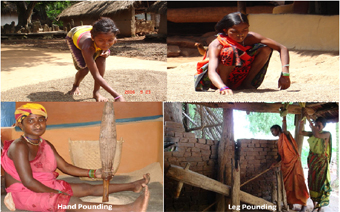
Figure-19: Food processing for the household - a regular activity
Recognitions and Awards
A number of organizations have recognized and rewarded the tribal communities of Koraput in appreciation of their significant contributions to the conservation of rice genetic resources and their improvement through selection, preservation and knowledge addition. In 2002, tribal women and men of Koraput were awarded with the International Equator Initiative's Innovative Partnerships Award for conservation of rice genetic diversity in situ and it's on farm conservation. The award was received by the community leader Ms Kamala Pujari, a tribal woman of Patraput at Johannesburg, South Africa (Fig.20 A). The award gave a way to form a local registered body i.e., the Panchabati Gramya Unnayana Samithi (PGUS) representatives from 16 villages with 48 women and 52 men. The Executive Committee consisting of 15 women and 17 men look after the activities related to biodiversity conservation, its enhancement and sustainable use and equitable sharing of benefits. The PGUS received Genome Saviour Award 2006 by the Protection of Plant Variety and Farmers Rights Authority (PPV&FR), Government of India for their outstanding and seminal contribution to the conservation of plant genetic resources particularly rice. Notably, such an award is the first of its kind in any biodiversity rich country in the world (Swaminathan, 2007). A tribal woman of Nuaguda village named Ms. Chandrama Mashia, president of SHG Mahila Swayang Sahayak received the 6th State Level Award FOLK AWARD - 2008 for her contribution in social mobilization, improving livelihood options, conservation, organizational strengthening, rural development and women empowerment (Fig. 20-D).
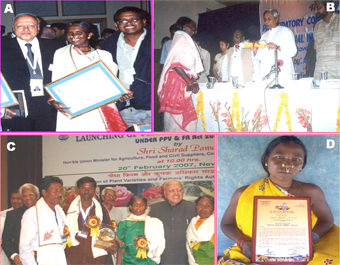
Figure- 20: Awards received by Tribal women of Koraput for their resource conservation efforts.
Conclusion
The study indicates that conservation and sustainable utilization of agrobiodiversity in the tribal villages of Koraput depend partly on traditional knowledge and skills of tribal women. Training on modern scientific knowledge on agricultural practices blended with traditional knowledge is required to enhance food production vis-à-vis conservation of local crops and varieties. In order to reduce women's drudgery during planting and food processing simple and feasible technology needs to be introduced that would encourage them to continue the cultivation of traditional food crops and varieties on-farm and food security at household level with diversified foods.
Acknowledgements
We are grateful to the tribal farm families for sharing their time, knowledge and active participation in various discussions and programs. The funding by different organizations- Ramon Magsaysay Award Foundation, FAO and Swiss Development for Cooperation are duly acknowledged. We are thankful to Prof M S Swaminthan for guidance, Ms Mina Swaminathan for encouragement and Dr Ajay Parida, Executive Director, MSSRF for facilitating the study.
References
- Das, Kornel (2006). Tribal Crop- Livestock Systems in South-East India. Manohar Publishers & Distributors, New Delhi. pp. 283.
- De Boef, Walter. S. (2000). Tales of the unpredictable, learning about institutional frameworks that support farmer management of agrobiodiversity, CIP - Data Koninklinje Bibliotheek, Den Haag.
- FAO (2005). Building on Gender, Agrobiodiversity and Local Knowledge .A Training Manual, pp. 78.
- Khooafkan, P. and M. A. Alteiri (2011) Globally important agriculture heritage systems- A legacy for the future. Food and Agricuture Organisation of the United Nations, Rome, pp. 41.
- Mishra S. and S.S. Chaudhury (2010) Landraces of rice: Traditional and Participatory Conservation Systems in Jeypore tract of Orissa. In: Genetic Resources of Rice in India - Past and Present, (Ed: S.D.Sharma), Today & Tomorrow's Printers and Publishers. pp 557-585.
- Mishra, S. and S.S. Chaudhury and V.A. Nambi (2012) Strengthening of traditional seed selection practices with improved knowledge and skills of tribal farm families in Koraput District. Indian Journal of Traditional Knowledge, 11(3), 461-470.
- Mishra, S. and S.S. Chaudhury (2012) Ethno botanical flora Used by Four Major Tribes in Koraput, Odisha, India. Genetic Resources and Crop Evolution,59 (5),793-804.
- Mohanti, K.K., P.C. Mohapatro and J. Samal (2006) Tribes of Koraput. Published by Council of Analytical Tribal Studies, Koraput, pp. 107.
- Oka, H. I. and W.T. Chang (1962). Rice varieties intermediate between wild and cultivated forms and the origin of the Japonica type. Bot. Bull. Acad. Sinica, 3: 109-131.
- Ramiah, K. and R.L.M. Ghose (1951).Origin and distribution of cultivated plants of south Asia - Rice. India Journal of Genetics, 11: 7-13.
- Senapati, N. and N.K. Sahoo (1966) Orissa District Gazetteers- Koraput. Orissa Govt. Press, Cuttack, pp. 155-187.
- Sharma, S.D., S. Tripathy and P. Gurung (1996).Chronicling Intellectual Property Contributions of Tribal/ Rural Women and Men of Orissa with reference to Conservation and Enhancement of Rice Genetic Resources. Report submitted to Ramon Magsaysay Award Foundation, Philippines.
- Sharma, S. D., S. Tripathy and P. Gurung (1998) Case studies of Jeypore Tract, Orissa. In :Gender Dimension in Biodiversity Management (Ed. M. S. Swaminathan) Konark publishers Pvt. Ltd., New Delhi, pp. 123-138.
- Swaminthan, M. S. (2000). Presidential address. In FAO Regional Technical Consultation: Gender Dimensions in Biodiversity Management and Food Security: Policy and Programme Strategies for Asia. M.S. Swaminathan Research Foundation, Chennai, India
- Swaminathan, M. S. (2007) Unsung guardians of food security. The Hindu, 17/02/ 2007.
- Tribes of Orissa (2004) Tribal and Harijan Research-cum-Training Institute, Bhubaneswar, Government of Orissa, Harijan and Tribal Welfare Department Orissa ,pp 295.
- Tripathy, S., P. Gurung and S.D. Sharma (2005) Intellectual property contributions with regard to rice genetic resources by tribes of south Orissa, India. Plant Genetic Resources Newsletter, IPGRI, Rome, Italy, 141:70-73.
Table-1 : Division of labour shared among tribal men & women in rice cultivation
|
Sl. No |
Activities |
Sub Activities |
Gender Participation |
|
|
Male |
Female |
|||
|
1 |
Farm Yard Manure (FYM) preparation &Application |
Collection of cow dung and other waste products for FYM and putting in the pit |
** |
|
|
Digging of Compost pit |
** |
|||
|
Decision for place for compost pit |
** |
** |
||
|
Decision to collect and apply FYM |
** |
** |
||
|
Transportation to the field |
** |
** |
||
|
Training attended for improved method of FYM preparation |
** |
** |
||
|
2 |
Ploughing |
Decision taken for 1stploughing after harvesting of the crops |
** |
** |
|
Preparation of plough &Yoke |
** |
|||
|
Decision purchasing of buffalo from local market (if required) |
** |
** |
||
|
Taking care of buffalo |
** |
|||
|
Ploughing |
** |
|||
|
3 |
Leveling |
Breaking the clods by wooden harmer in uplands |
** |
** |
|
Making or repairing of the leveler |
** |
|||
|
Leveling the low lands by wooden leveler |
** |
|||
|
4 |
Weeding |
Weeding from uplands |
** |
|
|
Weeding twice from medium &low land |
** |
|||
|
5 |
Broadcasting |
Sowing the seeds in uplands without soaking |
** |
|
|
Soaking the seeds in water for germination |
** |
|||
|
Broadcasting the seeds after soaking |
** |
|||
|
6 |
Nursery sowing |
Preparation of nursery bed |
** |
** |
|
Application of FYM in beds |
** |
** |
||
|
Nursery sowing |
** |
** |
||
|
Decision taken for Nursery sowing |
** |
** |
||
|
Water management of Nursery plots |
** |
|||
|
Taking care of Nursery plots |
** |
** |
||
|
7 |
Transplanting |
Cleaning of bundhs &preparation of fields |
** |
|
|
Decision taken for appropriate time for transplanting |
** |
** |
||
|
Decision taken for labour requirement &its payment |
** |
** |
||
|
Uprooting &transplanting |
** |
|||
|
Transplanting in line |
** |
** |
||
|
8 |
Application of chemical fertilizers and pesticides |
Decision taken for application of chemical fertilizers and pesticides |
** |
|
|
Purchase of fertilizer & pesticides |
** |
|||
|
Application in the field |
** |
|||
|
9 |
Application of Bio pesticides |
Collection &preparation for Bio pesticides |
** |
** |
|
Decision for application of Bio pesticides |
** |
** |
||
|
Identification of disease and pests |
** |
** |
||
|
Application of Bio pesticides in the field |
** |
** |
||
|
10 |
Seed Selection |
Rouging |
** |
|
|
Seed Selection in the field |
** |
** |
||
|
11 |
Harvesting |
Harvesting the crops |
** |
|
|
Decision for harvesting crop and labour payment |
** |
** |
||
|
Making bundles |
** |
|||
|
Transporting to the threshing yard |
** |
** |
||
|
Making "Gada"in the threshing yard |
** |
|||
|
12 |
Post Harvesting |
Threshing by bullock |
** |
|
|
Threshing by using modern threshing implements |
** |
|||
|
Sweeping and painting by cow dung |
** |
|||
|
Threshing for seed for next Kharif season |
** |
** |
||
|
Seed cleaning, winnowing &drying |
** |
|||
|
Grain cleaning &winnowing |
** |
|||
|
Weighing &Packing |
** |
|||
|
13 |
Storage |
Get ready the bamboo baskets for seeds by painting cow dung and straw |
** |
|
|
Knowledge & Application of Bio pesticides for seed preservation |
** |
** |
||
|
Decision taken for keeping the seeds in bamboo baskets &gunny bags |
** |
** |
||
|
Decision for appropriate storing place |
** |
** |
||
|
Taking care of the storage |
** |
|||



